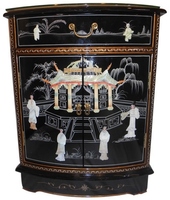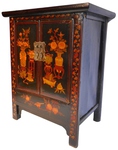
Here you can see a lacquered "Round Front Mother Of Pearl Shoe Cabinet"
"-But
what is Lacquer?", most of my customers ask me and even if I
try to give them a simple answer, I still have to go back 10000 years
BC, to find the right explanation.
"-But what is Lacquer?", most of my customers ask me and even if I try to give them a simple answer, I still have to go back 10000 years BC, to find the right explanation.
And we`ll go all way back to China! Man, these people knew that the whole civilization would depend on the compass, silk, tea, porcelain and...lacquer, so they invented these commodities.
In the beginning to keep it simple , the lacquer was made using the resin of the varnish tree. Collecting it is the tricky part, because the resin is pernicious while still wet (poison ivy related) and it can be done only in June and July, in the hours before sunrise. Once the lacquer is treated, it's no longer toxic and makes a hard durable, water proof finish.
The sap after extraction would be heated to remove water and impurities and then brushed on in layers.
Fine Asian ware may have more coats(some even hundreds). Even today's modern pieces are made this way, each being dried and smoothed with a whetstone, before the application of the next coat and after the hardening, and it's being engraved or carved.
Lacquer is a volatile substance and only few coloring agents will combine with it. That`s why in most Asian pieces we will see black (addition of charcoal), or red (cinnabar/mercury), very little yellow or green. During the Tang Dynasty the lacquer process developed to artistic craft, and more colors, shapes, techniques have been added, like inlaying lacquer or engravings with gold, silver and mother of pearl, carved lacquers, animal, birds, flower shapes were added as decorations. The style continued to the Song Dynasty and since then it had constantly developed and evolved into the fine art funiture that we import today.

If you are interested in old lacquerware you can visit a Buddhist monastery in China, but if you want to buy some, well...the monks are tough, they won`t sell them.
Instead, you can visit Oriental Furnishings online or our 7000 sq. ft. showroom in Norwalk Ct. This is where you will find antiques, and Contemporary imports brought by us from the oldest manufacturing provinces in China.


